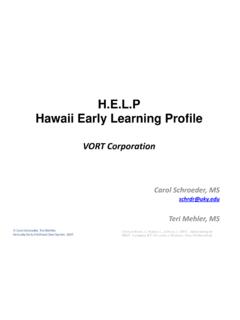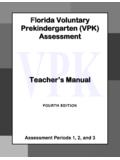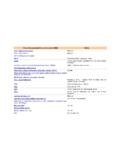Transcription of The Early Learning Accomplishment Profile (E-LAP) - Keds
1 The Early Learning The Early Learning Accomplishment Profile (EAccomplishment Profile (E--LAP)LAP)Presented by: Presented by: Linda Comley, Early Childhood Specialist Berea RTCL inda Comley, Early Childhood Specialist Berea RTC116 Jane Street116 Jane StreetPO Box 159PO Box 159 Berea, KY. 40403 Berea, KY. by Tiffany Stevens, IECE/ EKU Student &Developed by Tiffany Stevens, IECE/ EKU Student &Linda Comley, Berea RTCL inda Comley, Berea RTCS ession ObjectivesSession ObjectivesParticipants will develop:Participants will develop:ooan understanding of Kentuckyan understanding of Kentucky s s Continuous Assessment System for Early Continuous Assessment System for Early understanding of the Early Learning an understanding of the Early Learning Accomplishment Profile (EAccomplishment Profile (E--LAP).)
2 LAP).ooskills necessary to administer, score and skills necessary to administer, score and use the data obtained for educational use the data obtained for educational is Continuous What is Continuous Assessment?Assessment?A Continuous Assessment System, as A Continuous Assessment System, as defined by the Kentucky Department of defined by the Kentucky Department of Education (March, 2004) has the Education (March, 2004) has the following features:following features: Includes both formal and informal assessments Includes both formal and informal assessments that are conducted on a regular basis,that are conducted on a regular basis, Is integrated with instruction at various times,Is integrated with instruction at various times, Improves Learning and helps guide and direct Improves Learning and helps guide and direct the teachingthe teaching-- Learning process, Learning process, Should inform every aspect of instruction and Should inform every aspect of instruction and Building a Strong Foundation for School Success:Building a Strong Foundation for School Success:KentuckyKentucky s Early Childhood Standardss Early Childhood Standards Building a Strong Foundation for School Success.
3 Building a Strong Foundation for School Success: KentuckyKentucky s Continuous Assessment Guides Continuous Assessment Guide Building a Strong Foundation for School Success: Building a Strong Foundation for School Success: KentuckyKentucky s Early Childhood Quality Selfs Early Childhood Quality Self--Study for Study for Center Based Programs, Center Based Programs, Birth to FiveBirth to FiveContinuous Assessment SystemContinuous Assessment SystemChildren with Suspected DisabilitiesChildren with Diagnosed DisabilitiesStep 1: Screening Emotional/Social Self Help/Adaptive Cognitive Motor LanguageStep 3: Classroom/Instructional Set goals Develop strategies Implement Collect information Review progress Make referralsAll ChildrenStep 2: Diagnostic Health Developmental Sensory and/or BehavioralStep 2-A: ARC/IFSP MeetingsStep 2-B: Develop and Implement IEP/IFSPIDEAL egend:ARC: Admissions & Release CommitteeIEP: Individualized Education ProgramIFSP.
4 Individualized Family Service PlanDefinitionDefinition Classroom/instructional assessment is the ongoing Classroom/instructional assessment is the ongoing process of gathering information about childrenprocess of gathering information about children s s current capabilities (knowledge, skills, behavior, current capabilities (knowledge, skills, behavior, attitudes) then organizing and interpreting that attitudes) then organizing and interpreting that Meaningful assessment involves looking at Meaningful assessment involves looking at information from multiple sources gathered over information from multiple sources gathered over time before drawing conclusions about a young time before drawing conclusions about a young childchild s development and development and Assess?
5 Why Assess?The Responsibility to AssessThe Responsibility to AssessFrom the joint position statement of NAEYC and the National AssoFrom the joint position statement of NAEYC and the National Association of ciation of Early Childhood Specialists in State Departments of Education: Early Childhood Specialists in State Departments of Education:Policymakers, the Early childhood profession, and other stakehoPolicymakers, the Early childhood profession, and other stakeholders in young lders in young childrenchildren s lives have a shared responsibility to s lives have a shared responsibility to ..make ethical, appropriate, make ethical, appropriate, valid, and reliable assessment a central part of all Early childvalid, and reliable assessment a central part of all Early childhood programs.
6 Hood programs. To assess young childrenTo assess young children s strengths, progress, and needs , use assessment s strengths, progress, and needs , use assessment methods that are developmentally appropriate, culturally and linmethods that are developmentally appropriate, culturally and linguistically guistically responsive, tied to childrenresponsive, tied to children s daily activities, supported by professional s daily activities, supported by professional development, inclusive of families, and connected to specific, bdevelopment, inclusive of families, and connected to specific, beneficial eneficial purposes: (1) making sound decisions about teaching and learningpurposes: (1) making sound decisions about teaching and Learning , (2) , (2) identifying significant concerns that may require focused intervidentifying significant concerns that may require focused intervention for ention for individual children, and (3) helping programs improve their eduindividual children, and (3) helping programs improve their educational and cational and developmental interventions.
7 (NAEYC & NAECS/SDE 2003,1) (NAEYC & NAECS/SDE 2003,1) Why Assess?Why Assess? To monitor childrenTo monitor children s development and s development and learninglearning To guide our planning and decision makingTo guide our planning and decision making To identify children who might benefit from To identify children who might benefit from special servicesspecial services To report to and communicate with others To report to and communicate with others (families, other professionals, program (families, other professionals, program evaluation and accountability)evaluation and accountability)What is sound assessment?What is sound assessment? Sound or appropriate assessment Sound or appropriate assessment instruments are reliable, valid, free of bias, instruments are reliable, valid, free of bias, and suited to childrenand suited to children s developmental s developmental characteristicscharacteristicsReliable assessments are:Reliable assessments are: Accurate and consistent.
8 Accurate and consistent. Yield similar results upon additional Yield similar results upon additional administrations and across examinersadministrations and across examinersValid Assessments:Valid Assessments: Measure what we want them to measureMeasure what we want them to measure Provide results that agree with other Provide results that agree with other information gathered in other ways about information gathered in other ways about the same behaviorthe same behavior Sample enough behavior to represent the Sample enough behavior to represent the whole child or give a good picture of childwhole child or give a good picture of child s s abilityabilityBias Free Assessments:Bias Free Assessments: Do not unfairly discriminate against a child Do not unfairly discriminate against a child or group of children on the basis of such or group of children on the basis of such factors as gender, urban or rural residence, factors as gender, urban or rural residence, socioeconomic status, family structure, socioeconomic status, family structure, ethnic origin, culture, and origin, culture.
9 And must be Assessments must be developmentally appropriatedevelopmentally appropriate Take into account patterns of uneven Take into account patterns of uneven developmentdevelopment Limited language skillsLimited language skills Sensitivity to contextSensitivity to context Limited interest in being testedLimited interest in being tested Inability to meet the demands of certain Inability to meet the demands of certain types of taskstypes of tasksHow do we assess young childrenHow do we assess young children s s development?development? Performance assessmentPerformance assessment Authentic assessmentAuthentic assessmentWhat should be assessed?What should be assessed? ChildChild s growth and development s growth and development Expected outcomes based upon curriculum, Expected outcomes based upon curriculum, teaching, standards, , standards, should assessment be done?
10 When should assessment be done? Before children enter school or program (parent Before children enter school or program (parent information, medical information, information from information, medical information, information from previous /programprevious /program DailyDaily--child observations/anecdotal noteschild observations/anecdotal notes Periodically: Periodically: initial & final assessmentsinitial & final assessmentsfocus focus on developmental domains, outcomes, etc. on developmental domains, outcomes, etc. interim assessmentinterim assessmentcan give you a reading on can give you a reading on how children are doing and whether changes need how children are doing and whether changes need to occurto occur Before and after unit, theme or projectBefore and after unit.))




